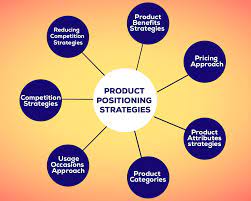
Introduction
In today’s fast-paced business world, standing out in a crowded marketplace is more challenging yet crucial than ever. Brand positioning is not just a marketing buzzword; it’s the cornerstone of a successful strategy in this era of information overload and consumer choice. Effective brand positioning involves crafting a unique identity that resonates deeply with your target audience, distinguishing your brand from competitors in a way that’s not just visible, but meaningful and sustainable. It’s about understanding your market, knowing your audience, and aligning your business values and message to create a powerful, memorable presence. This article explores the intricacies of brand positioning, offering insights and strategies to help your brand not only survive but thrive in competitive markets. For more on this, consider the Strategic Branding Expertise offered by BrandVillage Melbourne.
Understanding Brand Positioning
What is Brand Positioning?
Brand positioning is the art of creating a distinct and valued place for your brand in the minds of your target customers. It’s about strategically designing your brand’s offer and image so that it occupies a unique and advantageous position in their minds.
The Importance of Brand Positioning
Why Does it Matter?
In the digital age, where choices are abundant and attention spans are short, a strong brand positioning can be the difference between being a market leader and being overlooked. It enables you to cut through the noise, connect with your audience on a deeper level, and build lasting loyalty.
Crafting Your Brand’s Unique Position
Creating a unique position for your brand in a competitive market is akin to finding your voice in a chorus. It’s about being distinctive, resonant, and authentic. Here, we’ll explore the steps and strategies to craft a position that’s not just unique, but also deeply connected with your target audience.
Analyzing the Market
Knowing Your Terrain
Before you set your brand’s position, you need a clear understanding of the market landscape. What are the prevailing trends? Who are your main competitors, and what are they doing right (or wrong)? This knowledge isn’t just power – it’s your roadmap.
Identifying Your Target Audience
Speaking Their Language
Understanding your audience is like knowing the secret ingredients to a successful recipe. Who are they? What do they value? What problems do they face that your brand can solve? By getting to know them, you’re not just selling a product or service, you’re offering a solution that fits into their lives.
Developing Your Unique Value Proposition (UVP)
Your Brand’s Promise
Your UVP is your brand’s promise to your customers. It’s what makes you stand out in a sea of sameness. Is it innovation, customer service, product quality, or cost-effectiveness? Pinpointing your UVP is the cornerstone of your brand positioning strategy.
Leveraging Your Strengths
Playing to Win
What are your brand’s strengths? Maybe it’s your rich heritage, cutting-edge technology, exceptional customer service, or a strong community focus. Identifying and leveraging these strengths is crucial in carving out your unique space in the market.
Emotional Connection: The Heart of Brand Positioning
Building Relationships, Not Just Transactions
In the end, people choose brands that they feel an emotional connection with. How does your brand make them feel? Is it a sense of security, excitement, exclusivity, or belonging? Tapping into these emotions can transform a one-time buyer into a lifelong customer.
Consistency: The Key to Trust
Your Brand’s Signature
Be it your visual identity, tone of voice, or customer experience, consistency is key. It’s what builds trust and familiarity. Your audience should get the same essence of your brand, whether they see your ad, visit your website, or walk into your store.
Innovation and Adaptability: Staying Relevant
Evolving with the Times
The market is always changing, and so are your customers’ needs. Staying innovative and adaptable ensures your brand remains relevant and continues to meet these evolving needs.
Leveraging Your Strengths
In the journey of brand positioning, identifying and leveraging your strengths is like finding and polishing your own hidden gems. This process is essential to not only differentiate your brand but also to build a strong, lasting connection with your audience.
Discovering Your Unique Assets
What Sets You Apart?
Every brand has its unique set of strengths – it could be your unmatched customer service, innovative product features, a deep understanding of your customer’s needs, or even your brand’s heritage and story. Identifying these unique assets is the first step towards using them to your advantage.
Tailoring Strengths to Audience Needs
Aligning with Customer Desires
It’s not just about what you’re good at; it’s about how these strengths meet your customer’s desires and solve their problems. Does your innovative approach save them time? Does your exceptional customer service provide them with peace of mind? Aligning your strengths with customer needs makes your offering irresistible.
Authentic Storytelling: Showcasing Your Strengths
Tell Your Story
Your brand’s story is a powerful tool for showcasing your strengths. It’s not just about listing your achievements; it’s about telling a story that connects emotionally with your audience. Share your journey, the challenges you’ve overcome, and how your strengths have played a role in your success.
Consistency in Strengths
A Promise Delivered Every Time
Consistency in showcasing and delivering on your strengths builds trust and reliability. Whether it’s product quality or customer service, ensuring that your customers receive the same high standard every time reinforces your brand’s position in their minds.
Evolving with Your Strengths
Adapt and Grow
While it’s important to be consistent, it’s equally crucial to adapt and evolve your strengths in line with market trends and customer expectations. This shows your commitment to staying relevant and continually serving your customers better.
Celebrating Customer Feedback
Your Customers’ Voice
Incorporate customer feedback into your narrative. Let their stories and experiences demonstrate the real-life impact of your strengths. This not only validates your claims but also deepens the customer-brand relationship.
Conclusion
Navigating the complexities of brand positioning in competitive markets is no small feat. It requires a blend of creativity, strategic thinking, and a deep understanding of your market and audience. The key is to consistently deliver on your brand promise, stay true to your values, and continuously adapt to changing market dynamics. By doing so, you create not just a brand, but a legacy that resonates with your audience and stands the test of time. Remember, in the world of branding, it’s not just about being different; it’s about being authentically and memorably you. As we’ve explored various strategies and insights in this article, the path to achieving a unique edge in competitive markets becomes clearer, guiding your brand towards greater heights of success and recognition.
FAQs
1.What is the first step in brand positioning?
The first step is understanding your market and audience.
2.How important is emotion in brand positioning?
Emotion is key to creating a lasting connection with your audience.
3.Can brand positioning evolve over time?
Absolutely, brands must adapt to stay relevant.
4.How do you measure the success of brand positioning?
Through customer feedback, sales, and market share.
5.Is storytelling important in branding?
Yes, it helps create a memorable brand identity.







